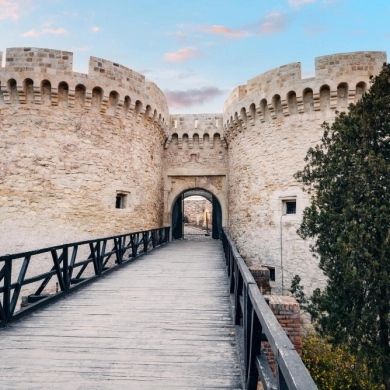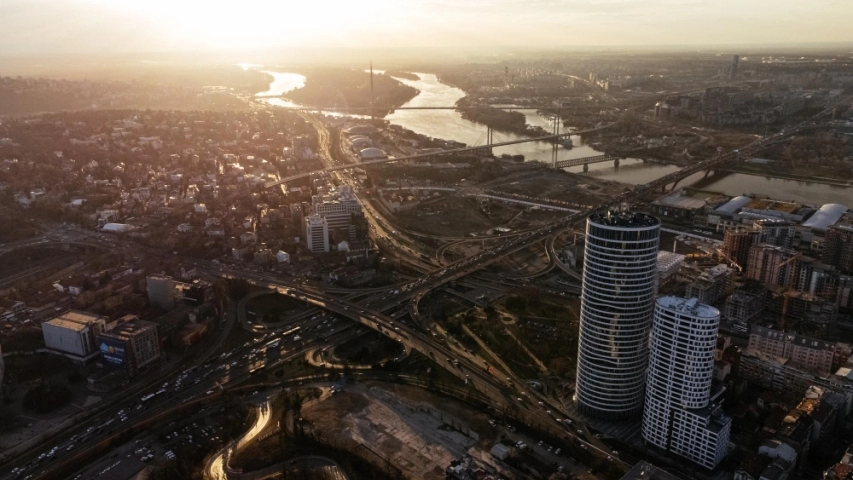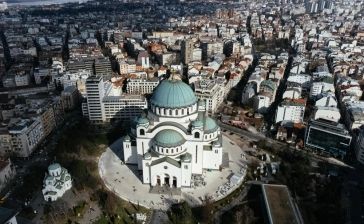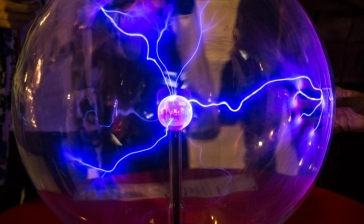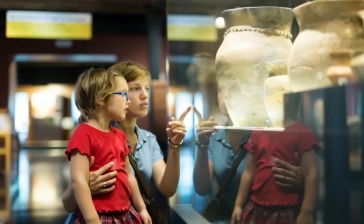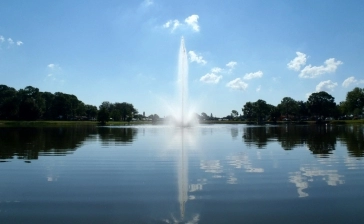Belgrade, the capital of Serbia, is a fascinating city with more than 7,000 years of history and a melting pot of cultures due to its strategic location between Eastern and Western Europe. Throughout its existence, Belgrade has been destroyed and rebuilt several times, giving it a unique character full of architectural and cultural contrasts. For a tourist who uses a wheelchair or a mobility scooter, the city offers a variety of accessible attractions and is increasingly working to improve its infrastructure for visitors with reduced mobility. Below, we will explore a bit of its history, some curious anecdotes, the most important places to visit, and tips for getting around the city.
A Brief History of Belgrade
Belgrade, whose name means "white city," has been inhabited since prehistoric times. Due to its strategic location at the confluence of the Danube and Sava rivers, it was an important point of interest for Romans, Byzantines, Bulgarians, Hungarians, Ottomans, and Austrians, among others. Each of these empires has left its mark on the city, and today you can see influences from all these cultures in its architecture and culture.
One of the most significant events in Belgrade's recent history was its devastation during the NATO bombings in 1999. Despite these difficult times, the city has managed to rise again and has become a vibrant and modern capital that combines history with a contemporary lifestyle.
Historical Anecdote: The Meeting Point of East and West
Belgrade has always been a geopolitical crossroads. During the Cold War, for example, it was a bridge between the communist East and the capitalist West. An interesting anecdote is that the former president of Yugoslavia, Josip Broz Tito, managed to maintain friendly relations with both the United States and the Soviet Union. His non-alignment policy made Belgrade a neutral place where leaders from both superpowers could meet. This role of mediator can still be felt in the city's multicultural atmosphere.
Important Places to Visit
Despite being a city that has suffered many wars, Belgrade has numerous monuments, museums, and green areas that are worth visiting. Here is a list of must-see places, adapted to the needs of people with reduced mobility:
- Belgrade Fortress and Kalemegdan Park
Belgrade Fortress is one of the city's most iconic landmarks. Situated on top of a hill overlooking the confluence of the Danube and Sava rivers, the fortress offers stunning views of the city and its surroundings. The main access to the park is fully wheelchair accessible, and the paths that run through Kalemegdan are paved, allowing for easy movement. However, some older parts of the fortress may have cobblestones, so it’s important to plan your route carefully.
Inside Kalemegdan, you’ll find monuments, statues, and museums, such as the Military Museum, which offers insight into Serbia’s military history. This museum has access for people with reduced mobility in most of its areas. - Temple of Saint Sava
The Temple of Saint Sava is one of the largest Orthodox churches in the world and a symbol of Serbian spiritual resilience. This impressive building stands in the heart of Belgrade, and its dome dominates the city’s skyline. For people in wheelchairs, the main entrance has a ramp for easy access. Inside the temple, the floor is made of marble and is completely accessible. The paintings and majestic design make it a must-visit. - Republic Square and National Theatre
Republic Square is Belgrade's main meeting point. Here, you will find the National Theatre and the statue of Prince Mihailo, one of the city’s most important monuments. The square is fully accessible, with a flat surface and open spaces. The National Theatre, although historic, has been renovated to offer access for people with reduced mobility, allowing them to enjoy cultural events such as operas and plays. - Ada Ciganlija
Known as Belgrade’s “sea,” Ada Ciganlija is a river island turned peninsula, famous for its beaches, walking and cycling paths, and water sports areas. The island has accessible paths, making it an ideal place to enjoy a day outdoors. Additionally, many of the bars and restaurants along the coast are adapted for people with reduced mobility. - Nikola Tesla Museum
The Nikola Tesla Museum is a tribute to the famous Serbian inventor, known for his contributions to alternating current and other technological innovations. The museum is located in a historic villa, and although some areas may have steps, ramps and proper wheelchair access have been implemented. Inside, you can see some of Tesla’s inventions and learn more about his life and work. - Museum of Yugoslav History
The Museum of Yugoslav History offers a detailed look at the history of the country that once united the Balkans. Part of the complex includes the House of Flowers, where Josip Broz Tito’s tomb is located. This museum is fully accessible for people with reduced mobility, with ramps and elevators facilitating access to all areas.
Tips for Getting Around Belgrade
Belgrade has made significant strides in terms of accessibility, but there are a few important things to keep in mind if you are using a wheelchair or mobility scooter.
- Accessible Public Transport
Belgrade’s public transport system includes buses and trams accessible to people with reduced mobility. Many of the main lines, such as bus 31, which runs along the main street, are equipped with ramps and designated spaces for wheelchairs. Additionally, adapted taxis are also available, and you can book them in advance through local taxi apps like “CarGo” or by calling specific taxi companies that offer these services. - Streets and Pavements
The center of Belgrade, especially areas like Knez Mihailova and Kalemegdan, has smooth and accessible pavements. However, some older streets, such as those in Skadarlija, may have cobblestones that make movement difficult, so it’s important to plan your route carefully. - Accessible Accommodation
Many hotels in Belgrade, especially those from international chains, are fully adapted for people with reduced mobility, with ramps, elevators, and accessible bathrooms. Some short-term rental apartments also offer adaptations, so it’s worth researching and booking in advance.
Conclusion
Belgrade is a vibrant city, rich in history and culture, offering a wealth of accessible attractions for people in wheelchairs or using mobility scooters. From Belgrade Fortress to the Temple of Saint Sava, along with museums, squares, and parks, the city is constantly working to improve its infrastructure and ensure that all visitors can enjoy its heritage and beauty without significant barriers. With a little planning, it’s possible to have an unforgettable experience in this historic and charming Balkan capital.
Here is information about the main tourist offices in Belgrade, including the one at Nikola Tesla Airport, with a focus on accessibility for people with reduced mobility:
Tourist Office in Knez Mihailova
Located on the famous pedestrian street Knez Mihailova, one of the main commercial and tourist avenues in Belgrade, this is the most central and frequently visited tourist office. Here, you can get maps, guides, and recommendations about tourist attractions, restaurants, hotels, and cultural events. They also offer information on public transport and organized tours.
• Accessibility: The office is fully adapted for wheelchair users, with access ramps and a spacious interior.
• Accessible bathrooms: Although the office does not have bathrooms, there are accessible public facilities nearby on the same street.
Contact Information:
• Address: Knez Mihailova 5, 11000 Belgrade
• Phone: +381 11 26 35 622
• Email: bginfo.knezmihailova@tob.co.rs
• Hours: Monday to Saturday: 09:00 - 21:00; Sunday: 10:00 - 15:00
• Website: www.tob.rs
Tourist Office at Nikola Tesla Airport
This office is located in the international arrivals area of Nikola Tesla Airport. It offers maps, brochures, and personalized assistance on how to get to the city, public and private transportation recommendations, and the main attractions in Belgrade and Serbia.
• Accessibility: Fully accessible for wheelchair users, as the airport has ramps and elevators in all areas.
• Accessible bathrooms: There are accessible bathrooms available at the airport near the tourist office.
Contact Information:
• Address: Nikola Tesla Airport, international arrivals area
• Phone: +381 11 209 78 28
• Email: info-aerodrom@serbia.travel
• Hours: 09:00 - 21:30
• Website: www.beg.aero
Tourist Office at Central Train Station
The office located at the Central Train Station is very useful for travelers arriving by train or seeking information on rail transport. Here, you can get information on connections between Belgrade and other cities, both inside and outside Serbia, as well as maps and tourist guides.
• Accessibility: The station has been renovated and is accessible for people with reduced mobility, with ramps and elevators available.
Contact Information:
• Address: Central Train Station, Belgrade
• Phone: +381 11 36 12 732
• Email: bginfo.stanica@tob.rs
• Hours: Monday to Saturday: 07:00 - 13:30 (closed Sundays)
Tourist Office in Zemun
Located in the picturesque neighborhood of Zemun, this office provides tourist information about this historic part of the city, famous for its river views and architecture. It’s a great stop for those wanting to explore beyond Belgrade’s city center.
• Accessibility: The access is suitable for people with reduced mobility, with ramps and accessible paths near the office.
Contact Information:
• Address: Zmaj Jovina 14, Zemun, Belgrade
• Phone: +381 11 2192 094
• Website: www.tob.rs
Belgrade Card
Belgrade offers a tourist card called the Belgrade Card, which provides discounts and benefits for exploring the city. Below are the details about this card, including the attractions it covers and its accessibility for people with reduced mobility.
What is the Belgrade Card?
The Belgrade Card is a card designed to facilitate access to various tourist attractions and offer discounts on activities, restaurants, and transportation. It is valid for periods of 24, 48, or 72 hours, allowing tourists to choose the duration that best suits their stay.
What attractions can you visit?
The Belgrade Card offers discounts or free entry to a variety of tourist attractions in the city, including:
• Kalemegdan Fortress: A must-see in Belgrade, with free access to several sections.
• Museum of Yugoslav History: Discounted entry, including a visit to Tito’s tomb.
• Nikola Tesla Museum: Discounted access to learn more about the famous inventor.
• Boat tours on the Danube and Sava rivers: Discounts on cruises that offer a different perspective of the city.
• Walking tours in Zemun and the city center: Some of these tours are free or have significant discounts.
In addition to these attractions, the card also includes discounts at restaurants, bars, and services like bike or electric scooter rentals.
Does it include public transport?
Currently, the Belgrade Card does not directly include access to public transport, but tourists can purchase transport tickets separately through the BusPlus system, which allows travel on buses, trams, and trolleybuses within the city. However, the card offers discounts on panoramic bus tours and river cruises.
Prices and durations
The Belgrade Card is available in three versions:
• 24 hours: Approximately 10 EUR
• 48 hours: Around 15 EUR
• 72 hours: About 20 EUR
You can purchase it online or at specific sales points and activate it through its mobile app.
The Belgrade Card is completely digital and accessible via a mobile app, making it easy for all tourists to use. Many of the attractions included in the card, such as Kalemegdan Fortress and the Museum of Yugoslav History, are wheelchair accessible, although some sites, especially older ones, may have less adapted areas.
Public transport in Belgrade also offers some accessible options, with buses and trams equipped with wheelchair ramps, though it’s advisable to check routes in advance that best suit your needs.
How to acquire it?
The card can be purchased online on the official Belgrade Card website or at tourist offices in the city. Users receive a code to activate it on their mobile phones, allowing immediate use at participating attractions.
Contact Information:
• Website: www.belgradecard.rs
• Phone: (+381) 63 300240
• Email: info@belgradecard.rs
Airport
Belgrade Nikola Tesla International Airport is Serbia's main airport, located about 18 km from the city center. It has been renovated several times to improve its infrastructure and ensure that all passengers, including those with reduced mobility, can enjoy a comfortable and barrier-free experience. Below are all the advantages and adapted services the airport offers for wheelchair users.
- Accessible Entrances
The airport has fully accessible entrances for people with reduced mobility. The main entrances are equipped with ramps, facilitating access from parking areas to the terminals. In addition, all the access doors to the terminals are spaciously designed, allowing comfortable movement for wheelchairs. - Help Points and PRM Services
Nikola Tesla Airport offers a specific service for people with reduced mobility (PRM). If requested in advance (through the airline or when booking the flight), airport staff can provide assistance from arrival to boarding, including help with luggage and transfer to the boarding gate.
There are assistance points located in key areas, such as the main entrances and check-in zones. These points are clearly marked with the accessibility symbol, and assistance can be requested at any time. Additionally, the airport staff is trained to assist people with disabilities, ensuring a smooth experience. - Accessible Waiting Areas
The airport's waiting areas are equipped to accommodate people with reduced mobility. These areas have reserved spaces for wheelchairs near the boarding gates, making it easy for passengers to access flight information. The screens displaying flight details are positioned at a suitable height to be visible from a wheelchair. - Adapted Bathrooms
The airport has accessible bathrooms located in key areas within the terminals. These bathrooms are designed with wide doors, support bars, and sufficient space to maneuver a wheelchair. They are also clearly marked for easy location by passengers. - Accessible Parking
The airport offers adapted parking areas near the main terminal entrances, allowing direct and convenient access for people with reduced mobility. These spaces are wider than conventional ones and clearly marked with the international accessibility symbol. Airport staff can also provide assistance from the parking lot to the check-in areas. - Boarding and Disembarking
The boarding and disembarking process at Belgrade Airport is designed to be accessible. The boarding gates are equipped with jetways that allow barrier-free boarding. In the case of flights that require the use of buses to the planes, the airport also has adapted buses with ramps and space for wheelchairs, ensuring that all passengers can board the plane safely and comfortably. - Wheelchair Rental and Mobility Equipment Handling
The airport offers a wheelchair rental service for passengers in need. This service can be requested in advance or upon arrival at the airport. Additionally, staff are trained to handle the transport of mobility equipment, such as electric wheelchairs or scooters, ensuring they are safely loaded and unloaded from planes. (This service is only provided within the airport.) - Accessible Restaurants and Shops
Within the airport, the restaurants and shops are also adapted to be accessible. Counters are at a suitable height for wheelchair users, and many service areas have adapted tables and wide aisles for easy mobility. - Practical Information
• Free Wi-Fi: All areas of the airport offer free Wi-Fi, allowing passengers to stay connected at all times.
• Accessible information screens: The screens displaying flight information are placed in visible locations and at a suitable height for wheelchair users.
Getting from the airport to the city center:
To get from Belgrade Nikola Tesla International Airport to the city center, a person with reduced mobility has several accessible options. Below, we explain the available transportation methods, schedules, prices, and contacts for adapted taxis.
Bus
One of the most economical ways to reach the center of Belgrade is by using public transport. There are two main bus lines connecting the airport to the city center:
• Line 72 (Public bus):
- Route: From the airport to Zeleni Venac, one of the main bus stations in downtown Belgrade.
- Schedule: Operates from 04:00 to 23:40, with departures every 30 minutes.
- Journey time: Approximately 40 minutes, depending on traffic.
- Price: Around 89 RSD (less than 1 EUR) if you buy the ticket at a kiosk, or 150 RSD (1.30 EUR) if bought directly on the bus.
- Accessibility: Some buses are equipped with ramps and wheelchair spaces, but not all. It is advisable to check the availability of adapted buses at the airport stops.
Minibus A1 (Express service)
This direct and fast service connects the airport with the city center, stopping at key locations like Slavija Square and Novi Beograd.
• Schedule: Runs daily from 06:00 to 20:00, with departures every 20 minutes.
• Journey time: Approximately 30 minutes.
• Price: 300 RSD (about 2.5 EUR), payable directly to the driver.
• Accessibility: Minibuses are not always adapted for people with reduced mobility, so it is not the most recommended option if you need guaranteed accessibility.
Taxi
Taxis are the most convenient and direct option for people with reduced mobility. Here are the contacts of two companies that have adapted vehicles:
Belgrade Wheelchair Taxi:
- Phone: (+381) 63 631 324
- Email: info@wheelchairtaxi.rs
- Estimated price: Approximately between 1,800 and 2,500 RSD (15 to 21 EUR), depending on traffic and time of day.
- Accessibility: The vehicles are adapted for wheelchairs with ramps and special safety belts.
• Pink Taxi: - Phone: (+381) 11 9803
- Email: info@pinktaxi.info
- Estimated price: Similar to Belgrade Wheelchair Taxi, but with the advantage of a larger fleet.
- Accessibility: Some vehicles are adapted for wheelchairs. It is advisable to book in advance to secure an accessible vehicle.
Train (BeoVoz)
The BeoVoz local train system connects some suburban areas to the city center but does not have a direct stop at the airport. However, if you decide to use the train from other parts of the city, it's important to know that many stations have limited access for people with reduced mobility, and not all trains are adapted.
Private Transportation Services and Ridesharing Apps
In addition to traditional taxis, you can use services like CarGo, an alternative similar to Uber. CarGo offers adapted vehicle options if booked in advance through the app.
Transport within the city
In Belgrade, several transportation options are adapted for people with reduced mobility, allowing easy travel around the city. Below are the main transportation methods, how to access them, their line numbers, schedules, and prices, always considering accessibility.
Bus
The bus system in Belgrade is the most widely used form of public transport. Many of the buses on the main lines are adapted for people with reduced mobility, equipped with ramps and reserved spaces for wheelchairs. However, not all buses have these adaptations, so it is advisable to check the availability of adapted buses at the stops.
Main accessible lines:
- Line 31: Connects the center of Belgrade with the Konjarnik neighborhood.
- Line 72: Runs from Nikola Tesla Airport to the city center, specifically to Zeleni Venac.
• Schedule: Generally, buses operate between 04:30 and 23:30, with frequencies ranging from 10 to 30 minutes, depending on the line.
• Price: A single ticket costs approximately 89 RSD (0.7 EUR) if bought at a kiosk, or 150 RSD (1.30 EUR) if bought directly on the bus. The BusPlus system can be used to load money onto a card and use it on various forms of transport.
Tram
Trams in Belgrade are another convenient way to get around the city. Some trams are adapted for people with reduced mobility, although not all lines are fully adapted. Trams offer a picturesque way to explore the city and run through several key areas.
• Accessible lines: - Tram 2: Makes a circular route around the city center, which is useful for seeing several important points.
- Tram 9: Connects central areas with the city's peripheral neighborhoods.
• Schedule: Trams generally operate from 05:00 to 00:00, with frequencies of 10 to 20 minutes.
• Price: The cost is the same as for buses, using the BusPlus system.
Trolleybus
Belgrade’s trolleybuses are another transport option adapted for people with reduced mobility. Like buses and trams, some trolleybuses are equipped with ramps and special spaces for wheelchairs.
• Accessible lines: - Trolleybus 41: Connects central Belgrade with the Banjica neighborhood.
- Trolleybus 29: Runs from Ustanicka to Slavija.
• Schedule: Similar to buses and trams, they operate between 05:00 and 23:00.
• Price: Same as buses and trams, with the possibility of using the BusPlus card.
Train (BeoVoz)
BeoVoz is the local train system in Belgrade. Although not all stations are fully accessible, it is useful for traveling between the suburbs and the city center. The main stations, such as Beograd Centar and Novi Beograd, have adequate access for people with reduced mobility.
• Main accessible lines: - BeoVoz: Connects key points in the city, such as Beograd Centar, Vukov Spomenik, and Zemun.
• Schedule: Varies depending on the line, but generally operates from 05:00 to 23:00.
• Price: The pricing system depends on the distance traveled, but BusPlus can be used for shorter trips within the city.
Adapted Taxis
If you prefer a more personalized and direct transport option, adapted taxis are the most convenient choice. These companies offer vehicles equipped with ramps and sufficient space for wheelchairs, and it’s recommended to book in advance.
• Belgrade Wheelchair Taxi: - Phone: (+381) 63 631 324
- Email: info@wheelchairtaxi.rs
- Accessibility: Vehicles equipped with ramps and special restraints for wheelchairs.
• Pink Taxi: - Phone: (+381) 11 9803
- Email: info@pinktaxi.info
- Accessibility: Some vehicles in their fleet are adapted for people with reduced mobility. It’s recommended to call in advance to ensure the availability of these vehicles.
Ridesharing Apps (CarGo)
CarGo is an alternative similar to Uber in Belgrade. The app allows you to request adapted vehicles for wheelchairs if booked in advance. This is an efficient and accessible option for people who prefer private transport.
Skadarlija
Belgrade is a vibrant city, full of history, culture, and life. One of the most popular and touristic neighborhoods is Skadarlija, known as the bohemian district. With its cobbled streets, nostalgic atmosphere, and a great number of traditional restaurants and bars, Skadarlija offers an authentic experience of the soul of Belgrade. If you use a wheelchair, you can enjoy a visit to this area. Although some sections may have cobblestones, most of the main places are adapted or have alternative access. Now, I’ll take you on a tour of this neighborhood, imagining that you’re exploring it for a few hours.
We begin at the entrance of Skadarska ulica, the main street of the neighborhood, which has a slight slope but is accessible for most of its length. At the beginning of the street, you can already feel the bohemian atmosphere that makes this place famous. The houses and buildings are decorated with pastel colors and flowers on the balconies. This is where Belgrade’s bohemian life began in the 19th century when artists, poets, and musicians gathered to exchange ideas, create, and enjoy good food and local wine.
You move comfortably along the sidewalk, lined with cafés with terraces where musicians play traditional Serbian songs. The ground is somewhat uneven due to the cobblestones, but there are several smooth sections where you can move without any problems. You pass by the famous restaurant Tri šešira (Three Hats), one of the city’s oldest and best-known places. This restaurant has been a meeting point for cultural figures for over a century and still offers typical Serbian food today. It is accessible and has a side entrance adapted for wheelchairs, so you could enjoy a delicious meal here without any issues.
You continue along Skadarlija and come across small craft and souvenir shops, each with its own colors and charm. Here, you can stop and admire the works of local artists. The shops are accessible, with wide, barrier-free entrances, making it easy to enter and view the unique pieces of art and crafts.
You arrive at a small square, where the café tables mix with statues of historical figures from Belgrade. Skadarlija is also famous for its references to writers and artists. Here, you can see a statue of Đura Jakšić, an important Serbian painter and poet who used to frequent this neighborhood. In this part of the street, the slope is gentle, and the spaces are wide, allowing you to enjoy it without worrying about barriers.
As you move on, the atmosphere remains lively but relaxed. The next place you come across is the restaurant Dva Jelena (The Two Deer), another of the neighborhood’s most iconic spots. Here, like at Tri šešira, there is live music every night, with traditional music bands playing for the diners. This place is also accessible for wheelchair users, with an adapted entrance and staff always willing to help.
After enjoying the food and bohemian atmosphere, you continue along the lower part of Skadarska ulica, where the streets intersect with small art galleries and more antique shops. These places are easily accessible, and you can enter and exit with ease. At the end of the street, you reach the Skadarlija Theater, which remains an important cultural hub for the city. This theater has been renovated and features adapted access, allowing you to enjoy a play or a musical performance.
Throughout your tour, you can notice how the past and present blend. The building facades have retained their original style, but the neighborhood is full of life and is frequented by both tourists and locals who want to enjoy good food and a unique atmosphere. The cobbled streets are part of the charm, but as you move along, you’ll find some sections with smoother pavement and accessible alternatives.
You end your tour in a small square at the end of the street, a quiet place where you can rest. From here, you can look back and see how Skadarlija stretches out before you with its lights, music, and people enjoying the evening. It’s a neighborhood that, despite its old and bohemian appearance, is designed so that everyone, including people with reduced mobility, can enjoy its beauty and charm without worrying about physical barriers.
Skadarlija is undoubtedly one of Belgrade’s most attractive neighborhoods, not only for its rich history and culture but also for the welcoming atmosphere it offers to all its visitors.
Here are three accessible restaurants in Belgrade for people with reduced mobility:
1. Frans
Frans is an elegant restaurant known for its international and Mediterranean cuisine. Its signature dish is grilled steak. The restaurant is fully accessible, with ramps at the entrance and adapted bathrooms. The sophisticated atmosphere and excellent service make it a popular choice.
Contact Information:
• Address: Bulevar Oslobođenja 18a, Belgrade
• Phone: +381 11 264 1944
• Website: www.frans.rs
2. Homa Restaurant
Homa offers a fine dining experience with modern European influences. The signature dish is truffle risotto. The restaurant is accessible, with adapted bathrooms and ramps at the entrance.
Contact Information:
• Address: Senjanina Ive 2, Belgrade
• Phone: +381 11 328 6895
• Website: www.homa.rs
3. Madera
Madera combines international cuisine with Serbian touches. Its signature dish is roasted lamb. The restaurant is wheelchair accessible, with adapted bathrooms and staff trained to assist customers.
Contact Information:
• Address: Bulevar Kralja Aleksandra 43, Belgrade
• Phone: +381 11 323 1334
• Website: www.maderarestoran.com
